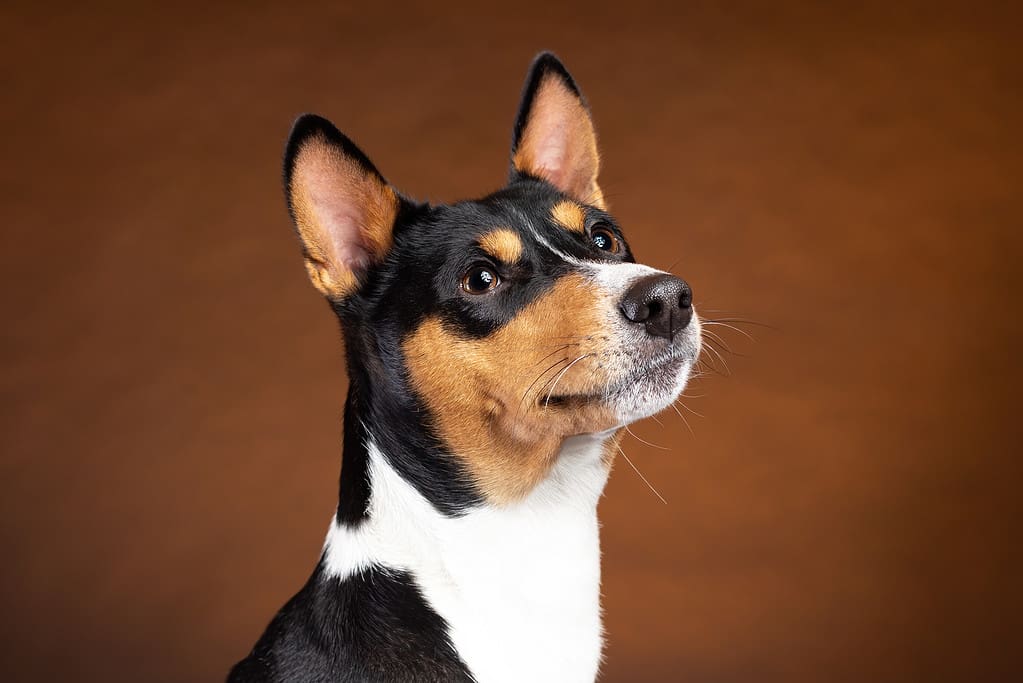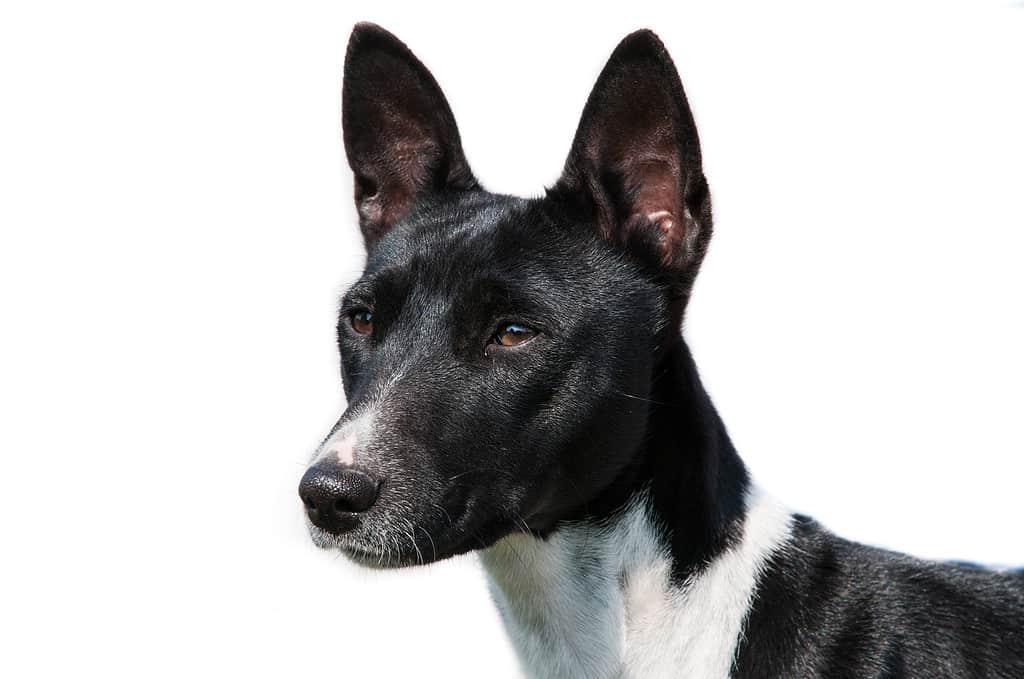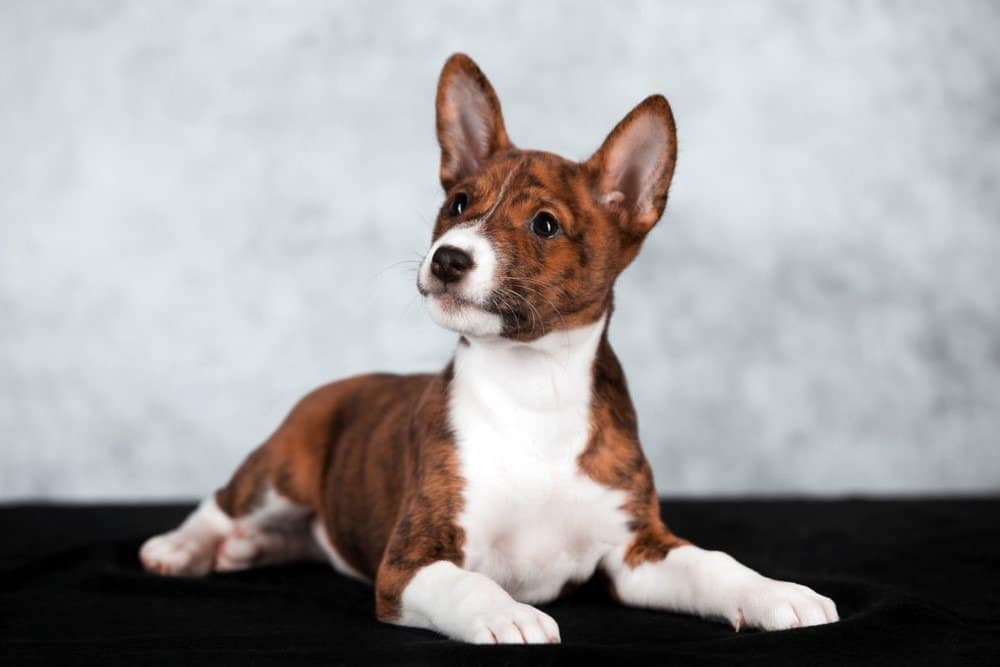Are you considering welcoming a basenji into your home, but aren’t sure which coat colors to go for or which ones are considered standard? This guide will give you all the information you need. We’ve listed the standard basenji colors from rarest to most common below. You’ll also find a list of other possible coat types you can expect to encounter.
But first, let’s quickly introduce basenjis and see how interbreeding affected their coat types and colors over the years.
A Very Short Intro to Basenjis

African tribes used basenjis as hunting and guard dogs.
©Grisha Bruev/Shutterstock.com
Basenji is considered one of the oldest dog breeds in the world dating back to over 6,000 years ago, as evidenced by cave artwork discovered in Libya and ancient Egyptian relics.
This breed originated in the Zaire region of Africa, known today as The Democratic Republic of Congo. This is why it is also often referred to as the “Congo Dog.” African tribes used them for both protection and hunting, which speaks volumes about this intelligent, active, and willful breed.
Even though they are one of the most popular dog breeds in Africa, they are not as popular in other parts of the world. However, basenji did make it to the big screen and gained popularity in the West, mainly thanks to the movie “Good-Bye, My Lady.”
Basenjis are known for their cat-like behavior, such as self-grooming, “yodeling” abilities, and their independent nature. Still, despite unique characteristics, this small-sized dog is not considered one of the more famous hound dogs.
Purebred basenjis have short, hypoallergenic coats. While interbreeding has introduced an increasing array of basenji colors, some hues have actually disappeared from the gene pool. Even more so, mixes bring the possibility of wavy fur as well.
It’s crucial to understand that a basenji’s personality or characteristics aren’t affected by their coat type nor color. These factors really only matter if you plan on entering your basenji into dog shows and competitions, or if you’re a breeder. Otherwise, there’s really no reason to be concerned about what your future pup’s coat will look like.
With that said, let’s review the standard basenji colors, from rarest to most common.
Standard Basenji Colors
According to The United Kennel Club (UKC), acceptable colors for purebreds include:
- Chestnut red
- Tri-color (pure black, chestnut red, and white)
- Brindle (black stripes on a background of chestnut red)
- Black (pure black)
Despite their primary coat color, all basenjis should have white feet, chest, and tail tips to fit the “standard” description. White legs, blaze, and collar are optional.
Basenji Club of America adds the following criteria to that description: “The amount of white should never predominate over primary color. Color and markings should be rich, clear, and well-defined, with a distinct line of demarcation between the black and red of tricolors and the stripes of brindles.”
Some serious faults include creams and shaded or off colors.
#1 Chestnut Red

Most basenjis have warm red markings.
©Yurikr/iStock via Getty Images
Chestnut red is the most common color for basenjis. It is a rich, warm red that sometimes looks slightly orange. Depending on factors like where they live or the weather conditions, some basenjis might have coats that appear a tad tan.
Like the pure black, chestnut red basenjis have bright white patches, and the colors don’t mix or bleed into each other, staying distinctly separate.
#2 Tri-Color

Tri-color basenjis have incredibly interesting markings. The colors also stay distinctly separate, just like in chestnut-red basenjis.
©Irina Nedikova/iStock via Getty Images
Tri-color basenjis are like little canvases with beautifully arranged black, red, and white colors. The white is usually found in the common places (chest, feet, and tail tips), while the black and reddish-brown color (or chestnut-red) highlights their eyebrows, cheeks, and some parts of their legs and ears.
This is also a fairly common color.
If two Tri-Color basenjis have puppies, you could have a mix of black, reddish-brown, or even a patterned (brindle) puppy.
#3 Brindle

Some say that brindle basenjis look like mini tigers!
©SergeyTikhomirov/iStock via Getty Images
Brindle is a newer recognized color for basenjis, first acknowledged in the early 1980s. Brindle basenjis have a unique look with black stripes on a reddish-brown base and the usual white patches. Despite its late recognition, brindle is still a very common coat pattern in basenjis.
An interesting fact is that if you have puppies from two tri-color basenjis, you might get a unique mix called trindle, where puppies have the brindle pattern and three colors.
Like the others, brindle basenjis have hidden color traits in their genes, making the world of this dog breed even more intriguing.
#4 Pure Black

Pure black basenjis have extremely appealing, contrasting markings.
©Pavol Czako/iStock via Getty Images
Pure black basenjis are the rarest of these four standard colors. They have a sleek black coat with bright white patches typically found on body parts like their chest and feet. The black color is shiny and deep, and strikingly contrasts the white areas.
Regarding genetics, pure black basenjis have a hidden color trait that only shows up when bred with a particular type of basenji. So, if two pure black basenjis have puppies, surprisingly, they might get a tri-color puppy!
Rare Basenji Colors
Other “unofficial” purebred basenji colors are very rare. However, they can include the following variations:
#1 Black Brindle/Trindle
Trindle refers to a basenji with a tri-color coat where the brindle pattern replaces the usual chestnut-red areas.
#2 Cream
Cream coats occur when the chestnut-red genes are overtaken or substituted by a light yellow or soft cream hue.
#3 Blue Cream
In blue cream basenjis, a diluted black coat is accented with cream highlights, giving the coat a blue-like appearance.
#4 Sable
Sable basenjis feature a chestnut-red coat with black-tipped fur.
#5 Mahogany
Mahogany basenjis have a darker and richer coat, resulting from the mixing of chestnut-red and black genes.
4 Types of Markings
Basenjis have four types of markings.
It’s worth noting that these markings can appear in various combinations and may be accompanied by other features like white feet, chest, and tail tips, which are common in the breed.
#1 Brindle Markings — Common

As mentioned, some basenjis really look like tigers!
©OlesyaNickolaeva/Shutterstock.com
Brindle markings are the most common among basenjis. In this pattern, dark stripes overlay a lighter base coat color, giving the dog a tiger-stripe appearance. The stripes can vary in width and density.
#2 Black Mask — Less Common
The black mask marking refers to a dark patch of fur that covers the dog’s muzzle and sometimes extends up to the eyes. This marking is less common in basenjis and is often considered a unique feature.
#3 Black Saddle — More Rare
In the black saddle pattern, a patch of black fur covers the back of the dog, resembling a saddle. This marking is relatively rare among basenjis and is often considered a distinguishing feature.
#4 With Cap — Potentially the Rarest
The “with cap” marking refers to a distinct patch of color, usually darker than the base coat, that appears on the top of the dog’s head. This is also a rare marking in basenjis.
- FUN FACT: When judges in dog shows evaluate basenjis, the basenji standard has no disqualifications for color, leaving scope for color variations as seen in the native dogs.
FAQ
Do basenjis bark?
No, basenjis do not bark. Basenjis are known for their unique yodel-like vocalizations instead of traditional barking, earning them the label of “barkless” dogs. However, note that they can still growl.
Do basenjis smell?
No, basenjis usually don’t smell, mainly because of their feline-like self-grooming. This makes them the perfect house dogs.
Do basenjis need baths?
No, basenjis generally don’t need baths. Bathing is unnecessary for them unless they become especially dirty or messy.
Do basenji dogs cry?
Yes, basenjis do indeed cry. They can cry real tears just like humans.
The photo featured at the top of this post is © Grisha Bruev/Shutterstock.com
Ready to discover the top 10 cutest dog breeds in the entire world?
How about the fastest dogs, the largest dogs and those that are -- quite frankly -- just the kindest dogs on the planet? Each day, AZ Animals sends out lists just like this to our thousands of email subscribers. And the best part? It's FREE. Join today by entering your email below.
Thank you for reading! Have some feedback for us? Contact the AZ Animals editorial team.







